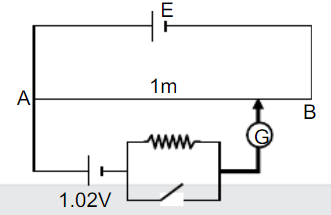In potentiometer experiment, null point isobtained at a particular point for a cell on potentiometer wire x cm long. If the lengthof the potentiometer wire is increasedwithout changing the cell, the balancing length will (Driving source is not changed)
(a)increase
(b)decreases
(c)not change
(d)become zero
The correct Answer is:A
To solve the problem step by step, we can follow these steps:
Step 1: Understand the Potentiometer Principle
The potentiometer is an instrument used to measure the potential difference (voltage) of a cell by balancing it against a known voltage. The balancing length (L) on the potentiometer wire is directly proportional to the voltage of the cell being measured.
Step 2: Define Initial Conditions
Let:
- L1 = initial length of the potentiometer wire
- l1 = initial balancing length for the cell
- E = electromotive force (emf) of the cell
- V = potential difference across the potentiometer wire
From the potentiometer principle, we have the relation:
EV=l1L1
This equation indicates that the balancing length l1 is proportional to the emf E of the cell and inversely proportional to the total length of the potentiometer wire L1.
Step 3: Increase the Length of the Potentiometer Wire
Now, if the length of the potentiometer wire is increased to L2 (where L2>L1), we need to find the new balancing length l2.
Using the same principle, we can write:
EV=l2L2
Step 4: Establish the Relationship Between Balancing Lengths
From the two equations, we can express l2 in terms of l1:
l1=E⋅L1V(1)
l2=E⋅L2V(2)
Step 5: Compare the Balancing Lengths
Since L2>L1, we can substitute the expression for l1 into the equation for l2:
l2=l1⋅L2L1
Step 6: Conclusion
Since L2L1>1 (because L2 is greater than L1), it follows that:
l2>l1
Thus, the balancing length will increase when the length of the potentiometer wire is increased.
Final Answer
The balancing length will increase.
---
The potentiometer is an instrument used to measure the potential difference (voltage) of a cell by balancing it against a known voltage. The balancing length (L) on the potentiometer wire is directly proportional to the voltage of the cell being measured.
Let:
- L1 = initial length of the potentiometer wire
- l1 = initial balancing length for the cell
- E = electromotive force (emf) of the cell
- V = potential difference across the potentiometer wire
EV=l1L1
This equation indicates that the balancing length l1 is proportional to the emf E of the cell and inversely proportional to the total length of the potentiometer wire L1.
Now, if the length of the potentiometer wire is increased to L2 (where L2>L1), we need to find the new balancing length l2.
EV=l2L2
From the two equations, we can express l2 in terms of l1:
l1=E⋅L1V(1)
l2=E⋅L2V(2)
Since L2>L1, we can substitute the expression for l1 into the equation for l2:
l2=l1⋅L2L1
Since L2L1>1 (because L2 is greater than L1), it follows that:
l2>l1
Thus, the balancing length will increase when the length of the potentiometer wire is increased.
The balancing length will increase.
Similar Questions
If the length of potentiometer wire is increased, then the accuracy in the determination of null point
View SolutionIf the resistance of potentiometer wire is 15r then calculate the balance length l

View SolutionLength of a potentiometer wire is kept long and uniform to ahcieve:-
View SolutionA cell in the secondary circuit gives null deflection for 2.5 m length of a potentiometer having 10m length of wire. If the length of the potentiometer wire is increased by 1m without changing the cell in the primary, the position of the null point wil be
View SolutionThe balancing length for a cell in a potentiometer experiment is 45 cm. In the balanced condition, the current through the potentiometer wire is 2 A. If the total length of the potentiometer wire is 1 m and its total resistance is60Ω , the emf of the cell is (in Volts) _________.
View SolutionIn given potentiometer circuit 1.02V is balanced at 5.1cm from A. Find potential gradient of potentiometer wire AB:

View SolutionIt is observed in a potentiometer experiment that no current passes through the galvanometer, when the terminals of the potentiometer, wire. On shunting the cell by a 2Ω resistance, the balancing length is reduced to half. The internal resistance of the cell is:-
View SolutionIn order to determine the internal resistance of a primary cell by means of potentiometer the emf of the battery connected across the ends of the potentiometer wire should be
View SolutionA potentiometer , with a wire of length 10 m, is connected to an accululator of steady voltage. A lenchlanche cell gives a null point at 7.5 m If the length of the potentiometer wire is increaseed by 1 m, find the new posistion of the balance point.
View SolutionAB is a potentiometer wire Fig. If the value of R is increased, in which direction will the balance point J shift ?
View Solution
